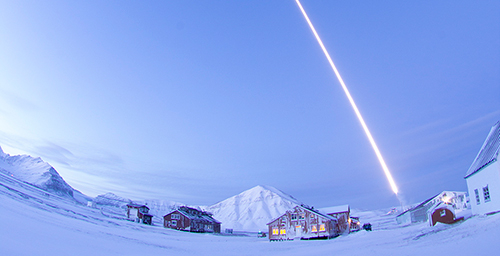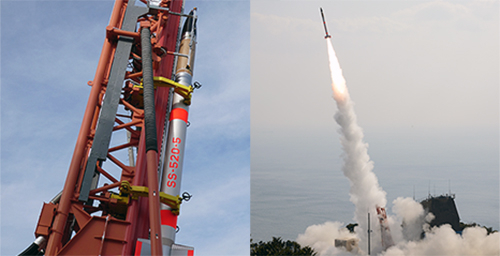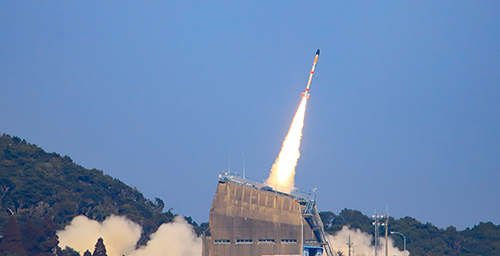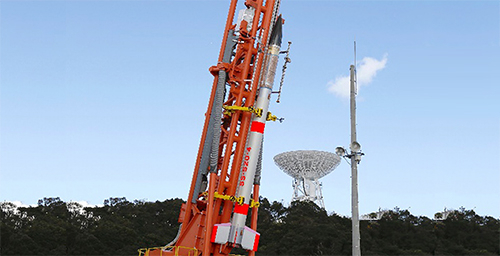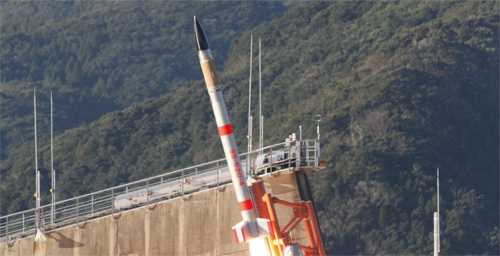The SS-520 is a two-stage rocket, the first stage of which comes from the main booster of the S-520. It has a capability for launching a 140 kg payload to an altitude of about 800 km.
The SS-520 aims at reaching 800 km altitude, and at the same time, carrying out technological experiments concerning the development of a mini-satellite launch vehicle by adding the third stage atop. The first stage is stabilized aerodynamically by use of tail fins like the S-520.
As the second stage is heavier than the head of S-520, the aerodynamic margin is secured more than ever. The whole motor case of the second stage is made of CFRP. The spin generated in the first stage is succeeded by the second stage, and it is utilized in the Rhumb-line control and spin stabilization.
The SS-520 debuted in January, 1998, and ISAS has a plan to launch it from Spitsbergen, Norway, to send a payload into the cusp region of the geomagnetosphere.
From observations by the magnetosphere observation satellite AKEBONO launched in 1989, it is known that large ion loss occurs at the polar cusp. This phenomenon is strange because the ions are supposed to be affected strongly by the earth's gravity. For this phenomenon to occur, a special heating or acceleration mechanism must be operating. While AKEBONO observed the range at several 1,000km, it is thought that the mechanism that heats the ions starts at a much lower altitude.
The region where ionic heating occurs is known as the "cusp" of the magnetosphere. The area called the "polar cusp" is the place which is connected with the daytime-side magnetospheric boundary with respect to the magnetism, where the energy of the solar wind plasma pours directly into the upper atmosphere. Research into the ion-heating mechanism near the polar cusp is a hot research topic currently, and NASA has already conducted rocket experiments at 1,400km and confirmed that ion heating was occurring. From the results of the NASA experiment, it was clear that the heating phenomenon starts lower than 1,400km, and for this reason ISAS aimed its rocket to examine the critical 1,000km to 1,200km altitude.
The most likely cause of ionic heating is electrostatic wave motion energized by electric current drive-type plasma instability. However, since the time and space variations of this phenomenon are very drastic, this detail has yet to be confirmed from the actual observation results. According to recent observation results from ground-based European incoherent scatter radar (EISCAT), it is known that there is ion loss from an altitude of several hundred km near the polar cusp. The EISCAT group is very interested in ISAS's rocket experiment too, and thus it was decided that the experiment should be conducted as a joint research project with EISCAT.
The cusp position targeted by the rocket experiment changes with the condition of the solar wind (particularly the polarity of the magnetic field), but on average it is at a magnetic latitude of 75°, and the magnetic local time is generally morning. For this reason, it was decided to launch the SS-520-2 rocket from Ny Olsen, Spitzbergen Island, Norway, the only launch site in the world that conforms to the above conditions. The experiment was scheduled for late November/early December (between November 25 and December 10), because neither sun nor moon will interfere with optical observation from the ground. Since there is a high probability that the phenomenon occurs just before noon, the launch time was set at 05~11UT, which is +/-3 hours around 08UT. The decisions on rocket launch would be based on the following information within the time zone.
The SS-520-2 rocket was launched at 6:16 PM (local Japan time) on December 4, 2000, from SvalRak (Ny Olsen), Norway, at an angle of elevation 86°, azimuth 192°. The rocket launch was normal, ignition occurred on schedule at 67 seconds for the first stage, 69 seconds for the second stage, and it reached its summit of 1,040km at about 600 seconds, before splashdown at about 1,100 seconds.
All telemetry and onboard instruments functioned smoothly, the boom and antenna deployed, and the high-voltage power supply to the various sensors went according to schedule. Telemetry reception was conducted in three locations, at Ny Olsen, Longyearbyen, and Andoya, and excellent data were acquired.
As for the rocket launch, by monitoring EISCAT radar data in realtime and solar wind plasma and interplanetary magnetic fields by ACE satellite, it was confirmed that the rocket actually flew above the cusp. The scheduled observation from the ground was impossible due to the weather, but from the observation data of the onboard instruments it was deduced that the vehicle flew above the cusp. Detailed analysis is to be performed upon the ISAS team's return to Japan.
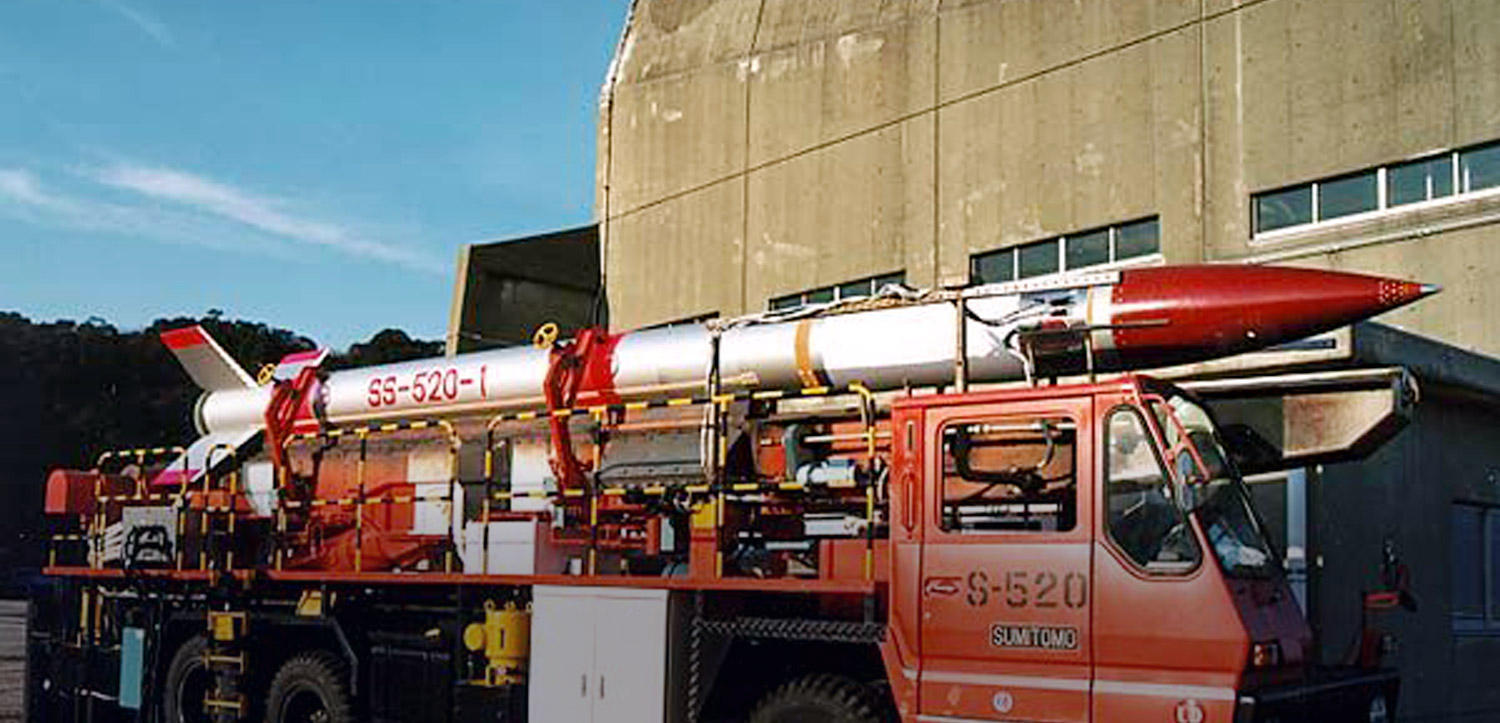
Sounding RocketsSS-520
The SS-520 is a two-stage rocket, the first stage of which comes from the main booster of the S-520. It has a capability for launching a 140 kg payload to an altitude of about 800 km.
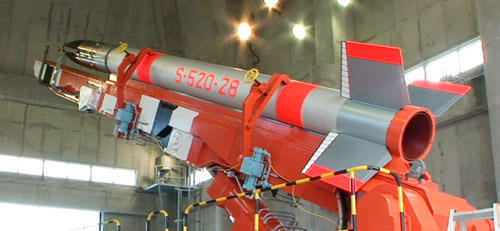 S-520
S-520

